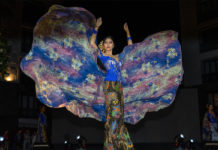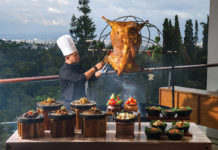Behind The F&B Scene
Restaurateur and nightlife impresario Reza Kadir is one of the masterminds behind Cacaote, a brasserie, bar and patisserie that has quickly become one of the hottest spots in the Senopati area of Jakarta. Having been a driving force behind many of the Indonesian capital’s trendy nightlife and F&B venues, Reza talks to Asia Dreams about his latest successful venture, the state of the F&B industry in the city and what Indonesia’s current demographic trends mean for the future.
The happening neighbourhood of Senopati, filled with hip new restaurants competing against long established favourites, is like a microcosm of Jakarta’s dynamic F&B scene. One of Senopati’s most popular new eateries is Cacaote, which combines a brasserie, bar and patisserie in one elegantly appointed package. Although open less than a year, it has already attracted loyal crowds of diverse customers – everybody from foodies to youngsters to office workers. What keeps them coming back is a potent combination of irresistible sweets, brilliant semi-fine dining fare, baroque setting and laid-back ambiance.
A place like Cacaote makes it look easy, but only a few people understand the intense planning and forethought that goes into making such an establishment successful. Reza Kadir is one of those people. One of the founding partners behind Cacaote, he has been involved in many of Jakarta’s notable F&B and nightlife ventures. As a veteran of the industry, there are few who could offer more insightful commentary on where the city’s F&B scene is now and where it’s going.
Your family has been in the industry for quite a long time, right?
It’s true. My late father opened the first dance club in Jakarta, Tanamur, in 1970. Well, actually that’s not true. There was this one other disco that was open like a month before. Fortunately, they lasted less than a year whereas Tanamur was open until 2005. Back then, they were called discotheques, not dance clubs. Before Tanamur, all you had were old school nightclubs with live bands playing either blues or jazz. It’s sort of hard to imagine a time before clubs with DJs, but Tanamur was one of the first.
We had a good run with the club. I took over Tanamur for its last three years. But after the crisis in 1997, a lot of the ex-pats fled the country, meaning we lost a big part of our clientele. Eighty to ninety percent of our customers were ex-pats. One weekend we were busy, the next – after the crash — we were down from 1,000 customers a night to 200-300. And then, in 1999 and 2002, we were attacked by Islamic fundamentalists that raided the club, smashing and tearing down whatever they could. So we ended up having to close down in 2005. But in all those years, my family has seen the gamut of what this city has to offer, and I’ve seen the selection of venues getting bigger and more ambitious.
What did you study in school to prepare you for a job in the industry?
I learned quite a bit about the F&B industry for my family, but I actually studied economics at university. Economics doesn’t really apply to my work now except at a very conceptual level. I will say, having an education that helps you look at the bigger picture is important in this business though.
Most of my practical knowledge comes from hands-on experience. I’ve done everything from take inventory in stock rooms to marketing and operations. You’re always learning and there’s always something new. Each venture, each restaurant, has a different dynamic because of the different people involved. Because, ultimately, it’s about people. I’ve had some triumphs and some failures in the past, but right now Cacaote is successful, so I’m happy. It’s nice to be part of a winning team
How has Cacaote changed since your first concept for the venue?
The concept for Cacaote has evolved since the beginning. At first, we were just going for a semi-fine dining/brasserie concept. Since then, we’ve added an all-day menu that is aimed more at young people who aren’t foodies but simply want to hang out. We also have a lunch menu, which is more streamlined and casual because we are targeting the office worker market as well. But in both our lunch and dinner menus, we really want to play with ingredients and textures to create something great.
What other plans do you have for Cacaote in the future?
People sometimes forget, but Cacaote is also a retail venue. Customers come in and get pastries take-away all the time. And that’s an aspect of the business that is doing very well. So at some point in the future, we might consider creating a standalone retail experience.
What are the demographics of your customers?
Our demographics have a big range, which is great because that gives us more options in the future in terms of what direction we’d like to take Cacaote. During the weekdays, we have a lot of ladies who come to have lunch together. They like the downstairs dining area because it’s more feminine, especially for teatime. But at three o’clock we have the youngsters coming in and around 4 or 5 o’clock the people from the South Central Business District start arriving. On weekends, it’s mostly families and youngsters.
Our customer base includes quite a wide range of people, which is certainly not something I was initially expecting. For example, I didn’t think we would be so popular with the younger demographic, especially our pastries. I had no clue – I’m not a pastry guy — so I thought that would be more something for the 30+ market or even families. I think [Executive Pastry Chef Darryl Iswaratioso] hit upon the sweet spot in terms of offering a product that young people would feel is an affordable luxury.
When you go to other venues, do you size them up in terms of their operations?
I do, actually. It’s a bad habit. I even do it when I go to street vendors! I really can’t help but look at the technical side of things, like their SOP and layout – where the cash register is set up, what the flow of the venue is, how the restaurant is set up etc. I don’t go in there with a checklist but, subconsciously, you get a feel for it after being in the industry for so long.
I’m big on lighting and spacing. I think a lot about floor plans and the flow of the restaurant in the planning stages. It’s still the case that Indonesians are more attracted to F&B venues for their ambience first, more so than the quality of their food.
Where do you see Jakarta’s F&B and nightlife industry today?
It’s becoming a more mature market. I wouldn’t say sophisticated, but it is becoming more mature in all sectors, from clubs to restaurants to lounges. A lot of it has to do with the supply-side of things. Nowadays, the quality and availability of ingredients is improving a lot even compared to just 5 years ago. Although prices can still be quite high.
Another big factor is that we are seeing a lot of Indonesians, who were studying abroad before, coming back from overseas and wanting to create quality restaurants and clubs like they experienced abroad. At the same time, a lot more Indonesians are getting exposure to higher-class venues, either through travel or through the media. And that has led to a lot of interesting concepts coming to Jakarta in just the last few years.
What is holding Jakarta and Indonesia’s F&B scene back?
The problem is, we’re simply a young nation. Well, maybe problem is the wrong word. We’re progressing but we need more time to develop because of our young demographics. For example, there are going to be 30 million new voters who will be voting for the first time in this year’s elections.
Jakarta’s F&B scene is definitely progressing. We’re seeing a lot of new interesting new concepts in terms of restaurants and cafés opening up. But in terms of the quality and ambience these places are offering, most still skew quite young. And that’s simply because their proprietors are young – many of them are in their late 20s to early 30s. Their artistic impulses and visceral aspirations are still those of a young person.
A lot of places here have quite a similar look, have you noticed that? Wooden chairs, moddish decor with a rustic 60s 70s-ish vibe mixed with a semi-finished industrial look? You see a lot of that because, first, the proprietors are still in that aesthetic phase. And two, so are the architects designing these places, because they’re young as well.
Where do you see the industry in 10 years?
I’d like to believe that in 10-15 years, the Jakarta scene will be a lot more optimal. By that I mean, the maturity of the ambiance and the quality of food will be there consistently. People who are now in their early 20s will, by then, be of age to spend good money on food instead of just wanting to sit around for hours drinking coffee – which does create ambience but not much else for an establishment.
I don’t see anything truly amazing coming out of Jakarta in the next 10 years. But that is just me looking at it from a statistical perspective. In Europe or the US, they have much more mature markets. America went through a similar change in the overall maturity of their market with the baby boomer generation in the 1970s.
So what Jakarta really needs is for the customers and the establishments to mature together. A ballet director once said that, to have a great performance, you need more than just a great ballet dancer, you also need an audience that can actually understand and appreciate the nuances of ballet. It’s a two-way street.





















